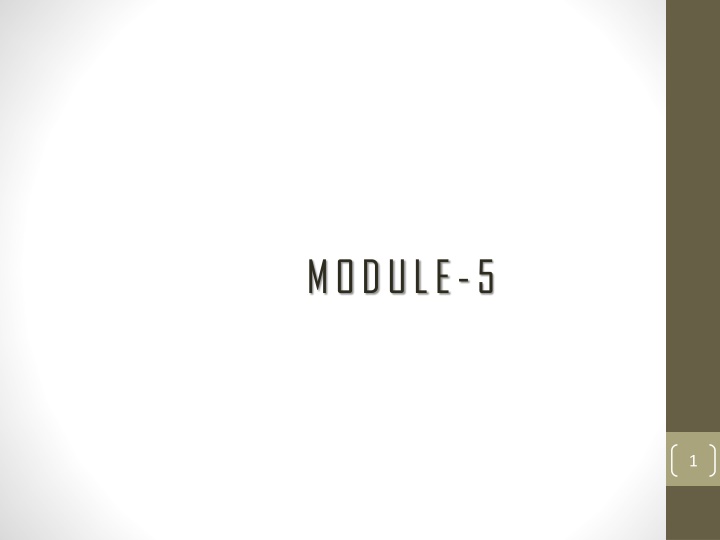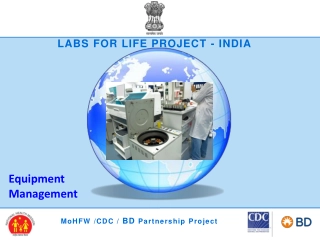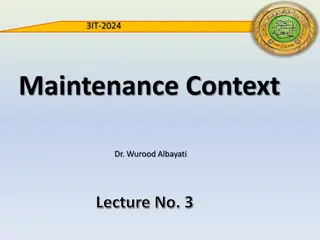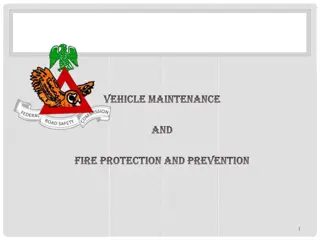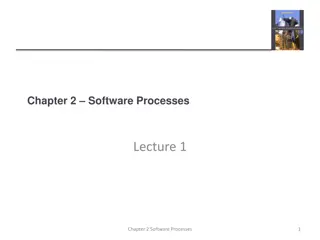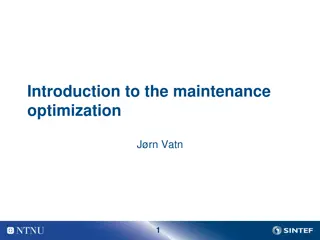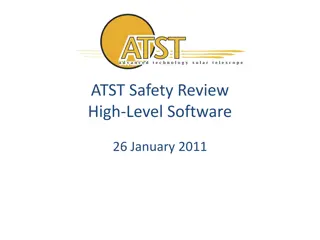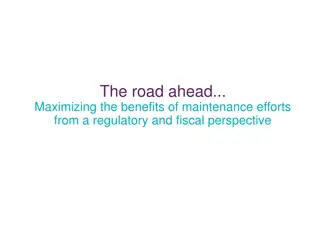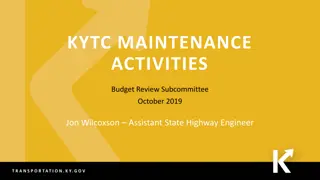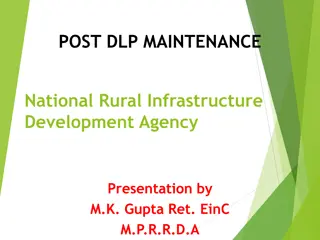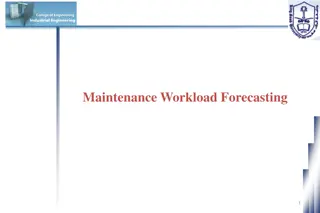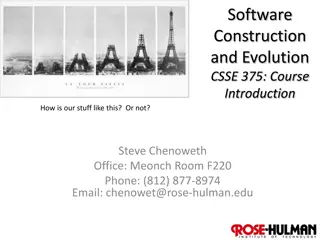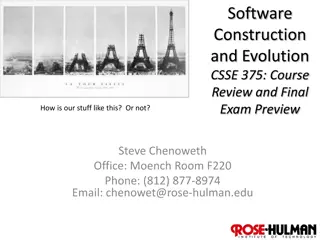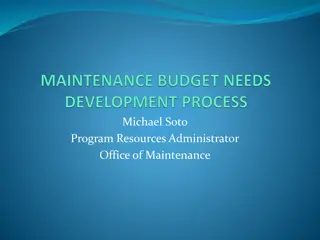Overview of Software Maintenance Process
Software maintenance is a critical phase post software delivery, encompassing error corrections, enhancements, deletion of obsolete features, and optimization. It aims to sustain software value over time by addressing defects and evolving capabilities. Maintenance comprises corrective, adaptive, and perfective categories, each serving unique purposes in ensuring software reliability and adaptability to changing environments.
Download Presentation

Please find below an Image/Link to download the presentation.
The content on the website is provided AS IS for your information and personal use only. It may not be sold, licensed, or shared on other websites without obtaining consent from the author.If you encounter any issues during the download, it is possible that the publisher has removed the file from their server.
You are allowed to download the files provided on this website for personal or commercial use, subject to the condition that they are used lawfully. All files are the property of their respective owners.
The content on the website is provided AS IS for your information and personal use only. It may not be sold, licensed, or shared on other websites without obtaining consent from the author.
E N D
Presentation Transcript
C O N T E N T S MAINTENANCE Overview of maintenance process Types of maintenance RISK MANAGEMENT Software risks Risk identification Risk monitoring and management PROJECT MANAGEMENT CONCEPT People Product Process Project 2
INTRODUCTION It is a task that is likely to happen when the software is delivered to the customer site, & it is installed and operational Delivery or release of a software inaugurates the maintenance phase of life cycle Consumes 40%-70% of cost of entire life cycle It may span for 20 years 4
INTRODUCTION Software Maintenance is a very broad activity that includes Error corrections Enhancements of capabilities Deletion of obsolete capabilities Optimization Any work done to change the software after it is in operation is considered as maintenance work The purpose is to preserve the value of the software over time 5
CATEGORIES OF MAINTENANCE Corrective maintenance Adaptive maintenance Perfective maintenance 6
CORRECTIVE MAINTENANCE This refer to modifications initiated due to defects appearing in the software, while it is in use Defects arises due to Design errors Logic errors Coding errors 7
CORRECTIVE MAINTENANCE Design errors occur when changes made to the software are Incorrect Incomplete Wrongly communicated Logic errors occur due to Invalid tests & conclusions Incorrect implementation of design specification Faulty logic flow Incomplete test data Coding errors arises due to Incorrect implementation of detailed design Incorrect use of source code logic Data processing errors System performance errors 8
ADAPTIVE MAINTENANCE It includes modifying the software to adapt to the changes in the environment. Environment refers to the external influences acting on a software Eg: Business rules Govt policies Work patterns Software & hardware platforms A change to the environment require modifications to the software Modifications happens when software moves to a different hardware or software platform 10
PERFECTIVE MAINTENANCE This maintenance happens for improving Processing efficiency Performance Changeability of the software User tries to expand the requirements & enhance existing system functionality This maintenance is also called Enhancement Enhancements are done to Make the product better Faster Better documented structured 11
Other types of maintenance Maintenance increase in the complexity of the software, The work is required to be done to reduce it, if possible. This work may be named as preventive maintenance. 12
PREVENTIVE MAINTENANCE. Aim of this maintenance is to make the program understandable Activities include Code restructuring Code optimization Documentation updating This reduces the complexity of the code 13
Problems during maintenance Often the program is written by one person & maintenance done by another person Often the program is changed by person who did not understand it clearly. Program listings are not structured. High staff turnover. 15
Solutions Budget and effort reallocation Time & resources are to be invested for the development of maintainable systems rather than un-maintainable systems Complete replacement of the system If maintenance cost of existing system is greater than cost of developing a new one, it is better to develop new one from scratch Maintenance of existing system Complete replacement of a system is not a viable option Current s/m must have the potential to evolve to the higher state Existing s/m must integrate to other ones in a cost effective manner 16
INTRODUCTION Every project is susceptible to risks Without effective risk management, even the planned projects become failure Project manager should anticipate & identify different risks susceptible to the project He should prepare contingency plans before hand to contain the risk Risk management It aims to reduce the chances of risk becoming real Also reduces the impact of a risk that becomes real 18
ACTIVITIES OF RISK MANAGEMENT 3 activities Risk Identification Risk Assessment Risk Mitigation 19
RISK IDENTIFICATION Project manager needs to anticipate the risks in the project as early as possible After identifying the risks, risk management plans are made Risk identification is similar to listing down the nightmares by the manager Eg: vendors not completing their work on time Poor quality work Manpower turnover 20
RISK IDENTIFICATION [2] To identify the risks systematically, we have to categorize risks into different classes Project manager examines the risks in each classes Identify the risks that are relevant to the project Categories of risks are Project risks Technical risks Business risks 21
RISK IDENTIFICATION [3] Project risks This include problems related to Budgetary Schedule Personnel Resource Customer related issues Important project risk is schedule slippage This arises since the software projects are difficult to monitor Due to its invisibility it is very difficult to asses the progress 22
RISK IDENTIFICATION [4] Technical risks It includes problems related to Potential design Implementation Interfacing Testing Maintenance Technical risks also includes Incomplete specification Changing specification Technical uncertainty Most of the technical risks arises due to insufficient knowledge about the product 23
RISK IDENTIFICATION [5] Business risks This includes Risk of building a product that no one wants Losing budgetary commitments To successfully identify risks, it is good to have a company disaster list Company disaster list Contains all the bad events that have happened to the s/w projects of the company over the years This list can be read by the project manager to be aware of susceptible risks to the project 24
R I S K A S S E S S M E N T Objective of risk assessment is to rank the risks in terms of their damage causing potential Each risk is rated in 2 ways The probability of risk becoming real (r) The consequence of problems associated with that risk(s) Based on these two factors priority of each risk is calculated P=r*s P priority with which the risk should be handled r probability of the risk becoming real s severity of damage caused if the risk becomes real If all the risks are prioritized, then the most likely and damaging risks are handled first 25
R I S K M I T I G A T I O N After identifying all risks, plans are made to control the most damaging and likely risks first Different risks have different containment/control procedures Strategies for risk containment Avoid the risk Transfer the risk Risk reduction 26
R I S K M I T I G A T I O N Avoid the risk Risks can be avoided in several ways Risks often arises due to project constraints So risks can be avoided by modifying the constraints Categories of constraints which give rise to risks Process related constraints Product related constraints Technology related constraints 27
R I S K M I T I G A T I O N Process related constraints Risks arises due to following constraints Aggressive work schedule Budget Resource utilization Product related constraints Risks arises due to Commitment to challenging product features Quality Reliability Technology related constraints Risks arises due to Use of certain technology 28
R I S K M I T I G A T I O N Risks can be avoided by Discussing with customer to change the requirements Giving incentives to the developers to avoid the risk of manpower turnover 29
R I S K M I T I G A T I O N Transfer the risks This involves getting the risky components developed by a third party Or buying insurance cover etc Risk reduction This involves planning different things to contain the damage due to a risk Eg: if there is a risk of manpower turnover, new recruitment can be planned Technical risks can be reduced by building a prototype of the technology that you are going to use 30
RISK MONITORING As the project proceeds, risk-monitoring activities commence. The project manager monitors factors that may provide an indication of the risk Risk monitoring is a project tracking activity Objectives Assess whether predicted risks occur or not Ensure that risk aversion steps defined for the risk are being properly applied Collect information that can be used for future risk analysis. 32
EXAMPLE: HIGH STAFF TURNOVER The factors monitored for the above risk The general attitude of team members based on project pressures Interpersonal relationships among team members Potential problems with compensation and benefits Availability of jobs within the company and outside it are all monitored 33
Other factors monitored Project manager should monitor the effectiveness of risk mitigation steps. Suppose that the risk mitigation step taken to resolve manpower turnover is proper documentation Manager has to monitor the following Check whether work products or documents are developed in a timely manner. This is to ensure continuity Newcomer gets necessary information from these documents, if he is forced to join the software team in the middle of the project 34
RISK MANAGEMENT Risk management is done if the risk mitigation efforts are failed & risk has become a reality In such a case, if we have followed mitigation strategy, then Backup will be available Information will be documented knowledge has been dispersed across the team. Newcomers must be added to the team to get up to speed. Those individuals who are leaving are asked to stop all work and spend their last weeks in knowledge transfer mode. This might include video-based knowledge capture, the development of commentary documents meeting with other team members who will remain on the project. 35
RMMM plan A risk management strategy can be included in the software project plan, The risk management steps can be organized into Risk Mitigation Monitoring Management plan. The RMMM plan documents all work performed as part of risk analysis It is used by the project manager as part of the overall project plan. 36
RISK INFORMATION SHEET Some software teams do not develop a formal RMMM document. Each risk is documented individually using a Risk Information Sheet (RIS) RIS is maintained using a database system Creation and information entry Priority ordering Searches Other analysis may be accomplished easily 37
INTRODUCTION Effective software project management focuses on the four Ps: People Product Process Project 40
P E O P L E The people factor is so important Software Engineering Institute has developed a People Capability Maturity Model (People-CMM), This is because, every organization needs to continually improve its ability to Attract Develop Motivate Organize Retain the workforce needed to accomplish its strategic business objectives 41
PEOPLE- CMM It defines following Staffing Communication and coordination Work environment Performance management Training Compensation Competency analysis and development Career development Workgroup development Team/ culture development Organizations that achieve high levels of People-CMM have a higher likelihood of implementing effective software project management practices. 42
P R O D U C T Before a project can be planned, Product objectives must be established Scope should be established Alternative solutions should be considered Technical and management constraints should be identified. Without this information, we cannot define Estimates of the cost Effective assessment of risk Breakdown of project tasks Manageable project schedule 43
P R O D U C T Stakeholders must meet to define product objectives and scope. Product Objectives Identify the overall goals for the product from the stakeholder s points of view Does not consider how these goals will be achieved. Scope identifies the Primary data Functions Attempts to bound these characteristics in a quantitative manner. 44
Once the product objectives and scope are understood, alternative solutions are considered. alternatives enable managers to select a best approach 45
PROJECT We conduct planned and controlled software projects to manage complexity Although the success rate for present-day software projects may have improved, project failure rate remains to be higher 46
METHODS TO AVOID PROJECT FAILURE Project manager and the software engineer must Avoid a set of common warning signs Understand the critical success factors Develop a commonsense approach for Planning Monitoring controlling the project. 47
THE PEOPLE People build computer software Projects succeed because well-trained, and motivated people get things done. But often they are taken for granted by the managers & other senior engineers 48
STAKEHOLDERS They are categorized into 5 Senior managers Define the business issues that often have a significant influence on the project. Project managers Who plan, motivate, organize, and control the practitioners who do software work. Practitioners Deliver the technical skills that are necessary to engineer a product or application. Customers Specify the requirements for the software to be engineered End users Interact with the software once it is released for production use. 49
TEAM LEADERS Every software project is populated by people who fall within this taxonomy. To be effective, the project team must be organized in a way that maximizes each person s skills and abilities. And that s the job of the team leader. 50
FEATURES FOR A GOOD TEAM LEADER MOI model of leadership states the following features Motivation. The ability to encourage technical people to produce to their best ability. Organization. The ability to mold existing processes or invent new ones Ideas or innovation. The ability to encourage people to create and feel creative even when they work within bounds of a particular software product 51
